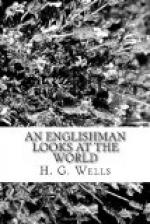impressions, and anxious for methods of comparison
between work and work, they begin to emulate the classifications
and exact measurements of a science, and to set up
ideals and rules as data for such classification and
measurements. They develop an alleged sense of
technique, which is too often no more than the attempt
to exact a laboriousness of method, or to insist upon
peculiarities of method which impress the professional
critic not so much as being merits as being meritorious.
This sort of thing has gone very far with the critical
discussion both of the novel and the play. You
have all heard that impressive dictum that some particular
theatrical display, although moving, interesting, and
continually entertaining from start to finish, was
for occult technical reasons “not a play,”
and in the same way you are continually having your
appreciation of fiction dashed by the mysterious parallel
condemnation, that the story you like “isn’t
a novel.” The novel has been treated as
though its form was as well-defined as the sonnet.
Some year or so ago, for example, there was a quite
serious discussion, which began, I believe, in a weekly
paper devoted to the interests of various nonconformist
religious organisations, about the proper length for
a novel. The critic was to begin his painful
duties with a yard measure. The matter was taken
up with profound gravity by the
Westminster Gazette,
and a considerable number of literary men and women
were circularised and asked to state, in the face
of “Tom Jones,” “The Vicar of Wakefield,”
“The Shabby-Genteel Story,” and “Bleak
House,” just exactly how long the novel ought
to be. Our replies varied according to the civility
of our natures, but the mere attempt to raise the question
shows, I think, how widespread among the editorial,
paragraph-writing, opinion-making sort of people is
this notion of prescribing a definite length and a
definite form for the novel. In the newspaper
correspondence that followed, our friend the weary
giant made a transitory appearance again. We
were told the novel ought to be long enough for him
to take up after dinner and finish before his whisky
at eleven.
That was obviously a half-forgotten echo of Edgar
Allan Poe’s discussion of the short story.
Edgar Allan Poe was very definite upon the point that
the short story should be finished at a sitting.
But the novel and short story are two entirely different
things, and the train of reasoning that made the American
master limit the short story to about an hour of reading
as a maximum, does not apply to the longer work.
A short story is, or should be, a simple thing; it
aims at producing one single, vivid effect; it has
to seize the attention at the outset, and never relaxing,
gather it together more and more until the climax is
reached. The limits of the human capacity to attend
closely therefore set a limit to it; it must explode
and finish before interruption occurs or fatigue sets
in. But the novel I hold to be a discursive thing;




